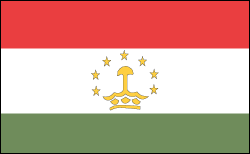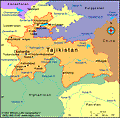Tajikistan
National name: Jumhurii Tojikiston President: Imomali Rakhmonov (1992) Prime Minister: Akil Akilov (1999) Land area: 55,251 sq mi (143,100 sq km); total area: 55,251 sq mi (143,100 sq km) Population (2007 est.): 7,076,598 (growth rate: 1.9%); birth rate: 27.3/1000; infant mortality rate: 43.6/1000; life expectancy: 64.6; density per sq mi: 128 Capital and largest city (2003 est.): Dushanbe, 817,100 (metro. area), 590,300 (city proper) Other large city: Khodzhent (Leninabad), 156,500 Monetary unit: somoni Languages: Tajik (official), Russian widely used in government and business Ethnicity/race: Tajik 79%, Uzbek 15.3%, Russian 1.1%, Kyrgyz 1.1%, other 2.6% (2000) Religions: Islam: Sunni 85%, Shiite 5%; other 10% (2003 est.) Literacy rate: 99% (2003 est.) Economic summary: GDP/PPP (2007 est.): $11.82 billion; per capita $1,800. Real growth rate: 7.8%. Inflation: 13.2%. Unemployment: 2.4% official rate; actual unemployment is higher. Arable land: 7%. Agriculture: cotton, grain, fruits, grapes, vegetables; cattle, sheep, goats. Labor force: 2.1 million (2007); agriculture 67.2%, industry 7.5%, services 25.3% (2000 est.). Industries: aluminum, zinc, lead; chemicals and fertilizers, cement, vegetable oil, metal-cutting machine tools, refrigerators and freezers. Natural resources: hydropower, some petroleum, uranium, mercury, brown coal, lead, zinc, antimony, tungsten, silver, gold. Exports: $950 million f.o.b. (2005 est.): aluminum, electricity, cotton, fruits, vegetable oil, textiles. Imports: $1.25 billion f.o.b. (2005 est.): electricity, petroleum products, aluminum oxide, machinery and equipment, foodstuffs. Major trading partners: Netherlands, Turkey, Uzbekistan, Latvia, Switzerland, Russia, Kazakhstan, Azerbaijan, U.S., China, Ukraine (2004). Communications: Telephones: main lines in use: 363,000 (1997); mobile cellular: 2,500 (1997). Radio broadcast stations: AM 8, FM 10, shortwave 2 (2002). Radios: 1.291 million (1991). Television broadcast stations: 13 (2001). Televisions: 820,000 (1997). Internet Service Providers (ISPs): 4 (2002). Internet users: 5,000 (2002). Transportation: Railways: total: 482 km (2002). Highways: total: 27,767 km (2000). Ports and harbors: none. Airports: 66 (2002). International disputes: prolonged regional drought creates water-sharing difficulties for Amu Darya river states; boundary agreements signed in 2002 cede 1,000 sq km of Pamir Mountain range to China in return for China relinquishing claims to 28,000 sq km of Tajikistani lands; negotiations with China resolved the longstanding boundary dispute; talks have begun with Uzbekistan to demine and delimit border; disputes in Isfara Valley delay completion of delimitation with Kyrgyzstan. |

Geography
Ninety-three percent of Tajikistan's territory is mountainous, and the mountain glaciers are the source of its rivers. Tajikistan is an earthquake-prone area. The republic is bounded by China in the east, Afghanistan to the south, and Uzbekistan and Kyrgyzstan to the west and north. The central Asian republic also includes the Gorno-Badakh Shan Autonomous region. Tajikistan is slightly larger than the state of Illinois.
History
The Tajiks, whose language is nearly identical with Persian, were part of the ancient Persian Empire that was ruled by Darius I and later conquered by Alexander the Great (333 B.C.). In the 7th and 8th centuries, Arabs conquered the region and brought Islam. The Tajiks were successively ruled by Uzbeks and then Afghans until claimed by Russia in the 1860s. In 1924, Tajikistan was consolidated into a newly formed Tajik Autonomous Soviet Socialist Republic, which was administratively part of the Uzbek SSR until the Tajik ASSR gained full-fledged republic status in 1929.
Tajikistan declared its sovereignty in Aug. 1990. In 1991, the republic's Communist leadership supported the attempted coup against Soviet president Mikhail Gorbachev. Tajikistan joined with ten other former Soviet republics in the Commonwealth of Independent States on Dec. 21, 1991. A parliamentary republic was proclaimed and presidential rule abolished in Nov. 1992. After independence, Tajikistan experienced sporadic conflict as the Communist-dominated government struggled to combat an insurgency by Islamic and democratic opposition forces. Despite continued international efforts to end the civil war, periodic fighting continued. About 60,000 people lost their lives in Tajikistan's civil war. The conflict ended officially on June 27, 1997, with the signing in Moscow of peace accords between the government of President Imomali Rakhmonov and the United Tajik Opposition (UTO), a coalition of largely Islamic groups. Since then, however, peace has been tenuous, marred regularly by killing sprees by various opposition groups.
In 2005 parliamentary elections, the president's governing party received 80% of the votes; international monitors pronounced them irregular. President Rakhmonov won a third term in the Nov. 2006 elections, which were boycotted by opposition parties. Since he came to power ten years ago, he has shut down the country's independent media and jailed opposition leaders. His government has also been accused of numerous human rights abuses and corruption.
See also Encyclopedia: Tajikistan.
Комментариев нет:
Отправить комментарий